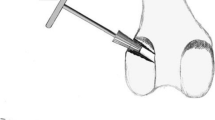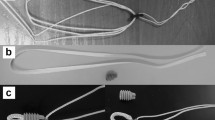Abstract
Background
A number of anterior cruciate ligament (ACL) fixation techniques are currently in use. Slippage or failure of the graft by excessive loading or aggressive rehabilitation may result in an unstable knee. Load and slippage of the ACL graft varies according to the fixation technique used.
Methods
Graft slippage, load to failure, and stiffness were evaluated using an animal model. Six soft tissue ACL fixation techniques and bone cement as a fixation device were tested: group A, Endo Button CL-Bio RCI; group B, Swing Bridge-Evolgate; group C, Rigidfix-Intrafix; group D, Bone Mulch-Washer Lock; group E, Transfix-Retroscrew; group F, Transfix-Deltascrew; group G, Kryptonite bone cement. Maximum failure load, stiffness, and slippage at the 1st and 1000th cycles and mode of failure were evaluated.
Results
The maximum failure load was significantly higher in group B (1030 N) and significantly lower in group E (483 N) than in the others. The stiffness of group B (270 N/mm) was significantly higher than the others. As for the mode of failure, group C showed failure in the femoral side in all tests (four device ruptures and two tendon ruptures on the femoral side). All failures of the other groups occurred on the tibial side except one test in group A. All failures in group G were due to slippage of the tendons.
Conclusion
Load to failure and stiffness was significantly different between the ACL fixation techniques. All but one of the fixation techniques showed sufficient properties for adequate postoperative rehabilitation. Bone cement used as a fixation device in soft tissue grafts did not seem to provide adequate initial fixation suitable for early rehabilitation after ACL reconstruction.
Similar content being viewed by others
References
Aglietti P, Buzzi R, Zaccerotti G, DeBiase P. Patellar tendon versus doubled semitendinosus and gracilis tendons for anterior cruciate ligament reconstruction. Am J Sports Med 1994;22:211–217.
Noyes FR, Butler DL, Grood ES, Zernicke RF, Hefzy MS. Biomechanical analysis of human ligament grafts used in knee-ligament repairs and reconstructions. J Bone Joint Surg Am 1984;66:344–352.
Kousa P, Järvinen TL, Vihavainen M, Kannus P, Järvinen M. The fixation strength of six hamstring tendon graft fixation devices in anterior cruciate ligament reconstruction. Part I. Femoral site. Am J Sports Med 2003;31:174–181.
Magen HE, Howell SM, Hull ML. Structural properties of six tibial fixation methods for anterior cruciate ligament soft tissue grafts. Am J Sports Med 1999;27:35–43.
Milano G, Mulas PD, Ziranu F, Piras S, Manunta A, Fabbriciani C. Comparison between different tibial fixation devices for ACL reconstruction with doubled hamstring tendon graft: a biomechanical analysis. Arthroscopy 2006;22:660–668.
Ferretti A, Conteduca F, Labianca L, Monaco E, De Carli A. Evolgate fixation of doubled flexor graft in anterior cruciate ligament reconstruction: biomechanical evaluation with cyclic loading. Am J Sports Med 2005;33:574–582.
Ferretti A, Conteduca F, Morelli F, Ticca L, Monaco E. The Evolgate: a method to improve the pullout strength of interference screws in tibial fixation of anterior cruciate ligament reconstruction with doubled gracilis and semitendinosus tendons. Arthroscopy 2003;19:936–940.
Benfield D, Otto DD, Bagnall KM, Raso VJ, Moussa W, Amirfazli A. Stiffness characteristics of hamstring tendon graft fixation methods at the femoral site. Int Orthop 2005;29:35–38.
Kleweno CP, Jacir AM, Gardner TR, Ahmad CS, Levine WN. Biomechanical evaluation of anterior cruciate ligament femoral fixation techniques. Am J Sports Med 2009;37:339–345.
Giurea M, Zorilla P, Amis AA, Aichroth P. Comparative pull-out and cyclic-loading strength tests of anchorage of hamstring tendon grafts in anterior cruciate ligament reconstruction. Am J Sports Med 1999;27:621–625.
Weiler A, Hoffmann RF, Stähelin AC, Bail HJ, Siepe CJ, Südkamp NP. Hamstring tendon fixation using interference screws: a biomechanical study in calf tibial bone. Arthroscopy 1998;14:29–37.
Shelbourne KD, Nitz P. Accelerated rehabilitation after anterior cruciate ligament reconstruction. Am J Sports Med 1990;18:292–299.
Kurosaka M, Yoshiya S, Andrish JT. A biomechanical comparison of different surgical techniques of graft fixation in anterior cruciate ligament reconstruction. Am J Sports Med 1987;15:225–229.
Yamanaka M, Yasuda K, Tohyama H, Nakano H, Wada T. The effect of cyclic displacement on the biomechanical characteristics of anterior cruciate ligament reconstructions. Am J Sports Med 1999;27:772–777.
Rodeo SA, Arnoczky SP, Torzilli PA, Hidaka C, Warren RF. Tendon-healing in a bone tunnel: a biomechanical and histological study in the dog. J Bone Joint Surg Am 1993;75:1795–1803.
Nagarkatti DG, McKeon BP, Donahue BS, Fulkerson JP. Mechanical evaluation of a soft tissue interference screw in free tendon anterior cruciate ligament graft fixation. Am J Sports Med 2001;29:67–71.
Paschal SO, Seemann MD, Ashman RB, Allard RN, Montgomery JB. Interference fixation versus postfixation of bone-patellar tendon-bone grafts for anterior cruciate ligament reconstruction: a biomechanical comparative study in porcine knees. Clin Orthop 1994;300:281–287.
Seil R, Rupp S, Krauss PW, Benz A, Kohn DM. Comparison of initial fixation strength between biodegradable and metallic interference screws and a press-fit fixation technique in a porcine model. Am J Sports Med 1998;26:815–819.
Xerogeanes JW, Fox RJ, Takeda Y, Kim HS, Ishibashi Y, Carlin GJ, et al. A functional comparison of animal anterior cruciate ligament models to the human anterior cruciate ligament. Ann Biomed Eng 1998;26:345–352.
Xerogeanes JW, Takeda Y, Livesay GA, Ishibashi Y, Kim HS, Fu FH, et al. Effect of knee flexion on the in situ force distribution in the human anterior cruciate ligament. Knee Surg Sports Traumatol Arthrosc 1995;3:9–13.
Donahue TL, Gregersen C, Hull ML, Howell SM. Comparison of viscoelastic, structural, and material properties of double-looped anterior cruciate ligament grafts made from bovine digital extensor and human hamstring tendons. J Biomech Eng 2001;123:523.
Weiler A, Hoffmann RF, Siepe CJ, Kolbeck SF, Südkamp NP. The influence of screw geometry on hamstring tendon interference fit fixation. Am J Sports Med 2000;28:356–359.
Saweeres ES, Kuiper JH, Evans RO, Richardson JB, White SH. Predicting in vivo clinical performance of anterior cruciate ligament fixation methods from in vitro analysis: industrial tests of fatigue life and tolerance limits are more useful than other cyclic loading parameters. Am J Sports Med 2005;33:666–673.
Pena F, Grøntvedt T, Brown GA, Aune AK, Engebretsen L. Comparison of failure strength between metallic and absorbable interference screws: influence of insertion torque, tunnel-bone block gap, bone mineral density, and interference. Am J Sports Med 1996;24:329–334.
Vuori I, Heinonen A, Sievänen H, Kannus P, Pasanen M, Oja P. Effects of unilateral strength training and detraining on bone mineral density and content in young women: a study of mechanical loading and deloading on human bones. Calcif Tissue Int 1994;55:59–67.
Steiner ME, Hecker AT, Brown CH Jr, Hayes WC. Anterior cruciate ligament graft fixation: comparison of hamstring and patellar tendon grafts. Am J Sports Med 1994;22:240–246.
Author information
Authors and Affiliations
About this article
Cite this article
Monaco, E., Labianca, L., Speranza, A. et al. Biomechanical evaluation of different anterior cruciate ligament fixation techniques for hamstring graft. J Orthop Sci 15, 125–131 (2010). https://doi.org/10.1007/s00776-009-1417-9
Received:
Accepted:
Published:
Issue Date:
DOI: https://doi.org/10.1007/s00776-009-1417-9




